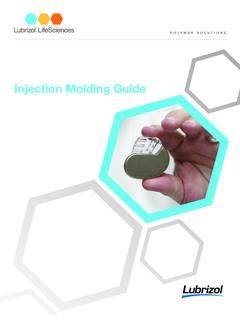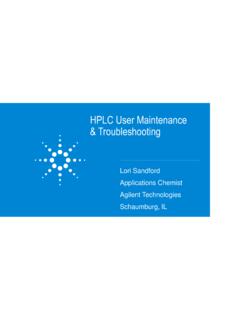Transcription of EXTRUSION PROCESSING GUIDE - Lubrizol
1 EXTRUSIONPROCESSING GUIDEADVANCING GUIDE CONTENTSI ntroduction .. Guidelines ..2 Equipment ..3 Common EXTRUSION Issues ..4 Polyurethane Films ..4 Cast Film and Sheet EXTRUSION ..4 EXTRUSION Coating ..5 Blown Film ..6 Wire and Cable Coating, Hose Jacketing ..7 Tubing and Profile EXTRUSION ..8 Trouble Shooting GUIDE ..923To learn more, visit is continuously expanding for specialty materials that have a combination of outstanding mechanical properties together with the capability of being converted on conventional thermoplastic PROCESSING equipment.
2 Lubrizol 's family of thermoplastic polyurethanes (TPUs) occupies a unique position of meeting this demand by providing a versatile range of grades from 70A Durometer to 77D Durometer that are being extruded commercially as wire and cable jacketing, hose jacketing, profiles, tubing, film & sheet, and fabric coatings. Lubrizol 's portfolio of EXTRUSION grade TPU includes Estane TPU, Pearlthane TPU, and Pearlcoat bulletin is intended to provide general guidelines for equipment, procedures, and EXTRUSION conditions that will help the customer obtain the best possible performance from Lubrizol 's portfolio of EXTRUSION grade TPUs.
3 Additional information can be obtained by contacting your Lubrizol technical service or sales polyurethanes are normally selected over polyester-based polyurethanes where end-use applications need hydrolytic stability, low temperature flexibility or fungal resistance. Although the polyether-based polyurethanes are inherently better in these characteristics, the hydrolytic stability and fungal resistance properties of polyester-based polyurethanes can be significantly improved by additive GUIDELINESL ubrizol TPUs must be properly dried before PROCESSING .
4 Inadequate drying results in a loss of properties and may give a poor appearance. Extruder barrel and die temperatures must be set properly for each product. Deviation from Lubrizol 's recommendations may result in poor EXTRUSION quality. These recommendations can be found on the technical data sheet. The rate of EXTRUSION has a large impact on the quality of the product and should be adjusted accordingly. TPUs in general can be tacky during PROCESSING , so rollers should be coated with suitable nonstick materials. Many Lubrizol TPUs are already formulated to reduce blocking and tackiness.
5 However, the addition of a lubricant masterbatch may be necessary to assure good PROCESSING . If a masterbatch or regrind/recycle are added to Lubrizol TPU, then these materials must also be properly dried and may have a significant impact on the quality of the product. Lubrizol TPUs do not draw down well compared to other thermoplastics like polyethylene, therefore, drawdown should be minimized in the process. It is not recommended to shut a line down on Lubrizol TPUs. Even during short breaks, material should be kept moving at slow rates through the Dehumidifying Hopper Dryer It is imperative to dry the material immediately prior to EXTRUSION .
6 This includes all raw materials containing Lubrizol TPU. Best results are obtained with or less moisture content. Because of the relatively high consumption rate of an extruder, a good dehumidifying hopper drier is a preferred method for delivering consistently pre-dried and pre-heated material to the feed screw. The inlet air to the hopper should be checked at intervals for both dryness and temperature. For most EXTRUSION grade TPU products, the hopper should be sized so that all of the feed has been subjected to a minimum of two hours of dehumidified, dried air at 105 C (220 F) for 2-3 hours.
7 A device to measure actual moisture content of the resin is recommended since dryer malfunctions can occur. Refer to individual technical data sheets for specific drying Most extruders are electrically heated with either band-type resistance heaters, cast-in block heaters or tubular resistance heaters wrapped around the barrel as seen in Figure 1. An efficient barrel cooling system is important to control the tendency for mechanical shear heat developed in the melt to override the electrical heater 1: Extruder1. Drive2. Feed3. Screw4. Barrel (Heater Bands)5.
8 Barrel Liner6. Screen Pack7. Breaker8. Die Body9. Die Head5. 1. 2. 3. 4. 6. 7. The optimal extruder barrel length for Lubrizol TPUs is 30-32 times its internal diameter (30:1 L/D, 32:1 L/D). Although shorter barrels can be used, mixing efficiency and melt uniformity are not optimal. Cooling to the extruder feed throat is critical to prevent surging or bridging. Internal cooling to the screw is not needed. Screw Design Excellent quality product has been obtained consistently with screws having the following characteristics: Barrier screw construction Compression ratio of 3:1 Long transition section (30-45% of screw length) Long metering section (30-45% of screw length) Hard-chrome, pinhole free, highly polished surface Clearance between screw and barrel liner of.
9 008 cm ( in.) - .013 cm ( in.)A properly designed screw should melt and homogenize the Lubrizol TPU material completely and develop a melt temperature about C (10 F) below the recommended melt temperature. Barrier type screws will give the best quality output and several designs have been used successfully. A mixing section is also recommended at the end of the screw. The best performance seen has been with Saxton type mixers . The design recommendations for a series of 30:1 screws are listed in Table 1. Proper maintenance of the screw will pay off in higher quality output, quicker start-ups, better output rates, and more reliable run-to-run performance consistency.
10 Breaker Plate & Screen The primary function of the screen pack is to filter contaminants out of the plastic melt ( paper, wood, metal, undispersed fillers, etc.). Screens should be constructed from stainless steel wire for strength and corrosion resistance. Normally a screen pack makeup of 20-40-80-20 mesh screens is optimal. However, some processes have used up to 200 mesh with good results. The breaker plate not only supports the screen pack, but also serves as a mechanical seal between the barrel and the adapter to the die. The holes in the breaker plate are normally cm (1/8 in.)





